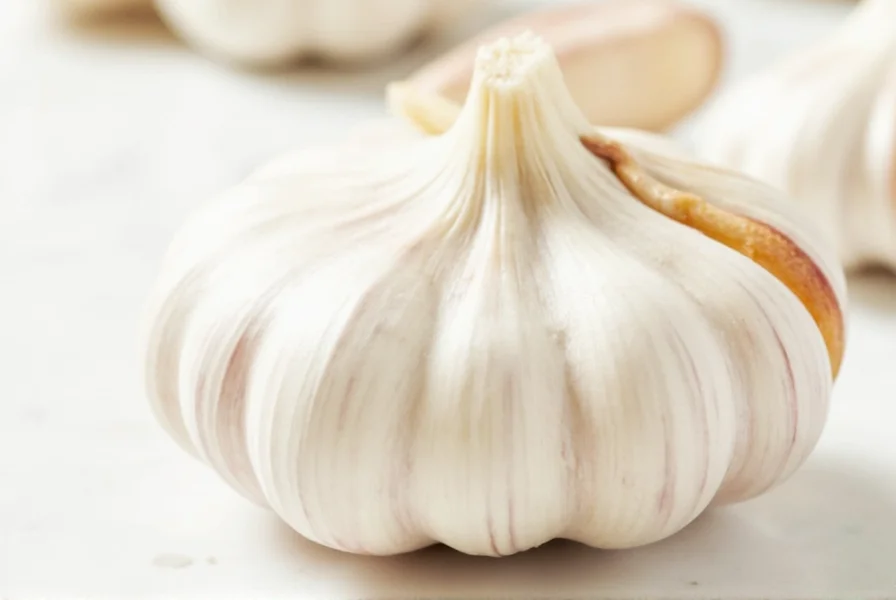Table of Contents
What Is a Clove of Garlic?
A clove of garlic is one individual segment of a garlic bulb (also called a head). It's the small, teardrop-shaped piece wrapped in its own papery skin that you separate from the larger bulb before using in cooking. Each clove contains the concentrated flavor and aroma that makes garlic a kitchen staple.
When a recipe calls for "1 clove of garlic," it means one of these individual segments, not the entire bulb. Understanding this distinction is crucial for accurate ingredient measurement in cooking.
How Many Cloves in a Garlic Bulb?
Most standard garlic bulbs contain 10-12 cloves, though this varies by variety:
| Garlic Type | Typical Clove Count | Clove Size | Flavor Profile |
|---|---|---|---|
| Hardneck Garlic | 8-12 cloves | Larger, uneven | Strong, complex, spicy |
| Softneck Garlic | 12-20 cloves | Smaller, uniform | Milder, sweeter |
| Elephant Garlic | 4-6 cloves | Very large | Very mild, almost sweet |
Hardneck varieties typically have fewer but larger cloves, while softneck types have more smaller cloves. Elephant garlic, though not true garlic (it's actually a leek relative), has significantly fewer but much larger cloves.
Practical Tips for Using Garlic
- Peeling technique: Place the clove on a cutting board, lay the flat side of a chef's knife over it, and give it a firm whack with your palm. This loosens the skin for easy removal.
- Minced vs. crushed: Minced garlic (fine pieces) provides subtle flavor, while crushed garlic releases more oils for stronger impact. Use minced for delicate dishes and crushed for robust sauces.
- Roasting: Roast whole bulbs (with tops cut off) at 400°F for 30-40 minutes for creamy, sweet garlic paste perfect for spreads and dips.
- Storage: Store whole bulbs in a cool, dark, dry place with good airflow. Never refrigerate whole bulbs, as moisture causes mold. Once peeled, store cloves in an airtight container in the fridge for up to 1 week.
- Cooking temperature: Add garlic near the end of cooking (last 1-2 minutes) to prevent burning. Burnt garlic turns bitter and loses its characteristic flavor.
Garlic Conversion Guide
When substituting fresh garlic with other forms, use these standard conversions:
| Form | Equivalent to 1 Fresh Clove | Best For |
|---|---|---|
| Minced fresh garlic | 1/2 teaspoon | Sauces, dressings, marinades |
| Crushed garlic | 1 1/2 teaspoons | Stir-fries, roasted vegetables |
| Garlic powder | 1/8 teaspoon | Seasoning blends, dry rubs |
| Garlic salt | 1/2 teaspoon | When you want added saltiness |
| Jarred minced garlic | 1 teaspoon | Quick recipes where fresh isn't available |
Remember: Fresh garlic always provides superior flavor compared to processed alternatives. Use conversions as a guide but adjust to taste based on your recipe's requirements.
Frequently Asked Questions
What exactly is a clove of garlic?
A single garlic clove is one individual segment of a garlic bulb (also called a head). It's the small, teardrop-shaped piece wrapped in its own papery skin that you separate from the larger bulb before using in cooking.
How many cloves are typically in a garlic bulb?
A standard garlic bulb usually contains 10-12 cloves, though this can vary by variety. Elephant garlic bulbs tend to have fewer but much larger cloves (about 4-6), while some specialty varieties might have up to 20 smaller cloves.
What's the difference between a garlic bulb and a garlic clove?
A garlic bulb (or head) is the entire round cluster you buy at the store, which contains multiple individual cloves. A clove is just one segment of that bulb. Think of the bulb as the whole package and cloves as the individual pieces inside.
How much minced garlic equals one clove of garlic?
One medium garlic clove, when minced, equals approximately 1/2 teaspoon of minced garlic. For crushed garlic, one clove equals about 1 1/2 teaspoons. If using garlic powder, 1/8 teaspoon equals one fresh clove.
Can I substitute garlic powder for fresh garlic cloves?
Yes, but the flavor profile differs. As a general rule, 1/8 teaspoon of garlic powder equals one fresh garlic clove. Keep in mind that fresh garlic has a brighter, more complex flavor, while garlic powder offers convenience and longer shelf life.
How do I know if a garlic clove has gone bad?
Signs of spoiled garlic include brown spots, soft or mushy areas, green sprouts in the center, or a sour smell. Fresh garlic should be firm, dry, and have a clean, sharp scent. Discard any cloves showing signs of mold or significant discoloration.
Why do recipes specify "cloves" rather than measurements?
Recipes often specify cloves because garlic size can vary significantly. Using "cloves" accounts for this natural variation better than precise volume measurements would. However, experienced cooks often prefer weight measurements (about 5-7 grams per medium clove) for more consistent results.
What's the best way to peel a garlic clove?
The most efficient method is to place the clove on a cutting board, lay the flat side of a chef's knife over it, and give it a firm whack with your palm. This loosens the skin, making it easy to peel off. Alternatively, you can microwave the clove for 10-15 seconds to loosen the skin.











 浙公网安备
33010002000092号
浙公网安备
33010002000092号 浙B2-20120091-4
浙B2-20120091-4